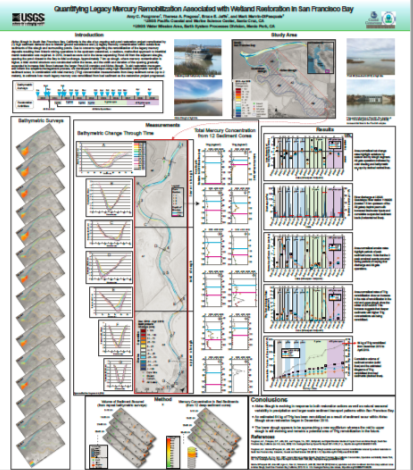Although there are numerous environmental and societal benefits to wetland restoration, potential negative impacts, such as legacy contaminant remobilization, must be considered as well. Alviso Slough in South San Francisco Bay, California, is the site of an ongoing salt pond restoration project complicated by (1) high sediment demand due to historic ground subsidence and (2) legacy mercury contamination within subsurface sediment of the slough and surrounding ponds. Due to concerns regarding the remobilization of the legacy mercury deposits resulting from historic mining operations in the upstream watershed, a cautious, methodical approach to intertidal marsh restoration was required. In 2010, breaches were cut in the levees separating the ponds and slough, opening the ponds closest to the Bay to tidal exchange. Approximately 7 km up slough, where mercury contamination is higher, a tidal control structure was constructed within the levee, and the width and duration of the opening gradually expanded to increase tidal flows between the pond complex and the slough. To aid restoration managers and inform the adaptive-management process, we developed a technique using high-resolution bathymetric surveys of sediment scour, in combination with mercury concentration measurements from deep sediment cores (up to 2 meters), to estimate how much legacy mercury was remobilized from bed sediment as the restoration project progressed. Here we present the results of nearly a decade of research, monitoring morphologic change, and mercury remobilization, on a biannual basis, since restoration began in 2010. A series of 15 bathymetric surveys reveals significant seasonal variability and a general pattern of increased erosion rates during the winter months and either decreased erosion or net sedimentation over the spring and summer months. We estimate that approximately 64 kg of total mercury was remobilized from the slough’s bed sediment from December 2010 to April 2019, with average, area-normalized rates of 3 mg/m2/month and the peak rate of 10 mg/m2/month occurred during the winter. When put in the context of environmental forcings, it becomes clear that sediment scour and legacy mercury remobilization was influenced not only by restoration actions, but also seasonal variability in precipitation and larger-scale sediment transport patterns within San Francisco Bay.
Citation:
Foxgrover, A.C., Fregoso, T.A., Jaffe, B.E., and Marvin-DiPasquale, M., 2020. Quantifying legacy mercury remobilization associated with wetland restoration in San Francisco Bay (abs)., Restore America’s Estuaries 2020 Summit: The National Coastal and Estuarine Virtual Summit, Sept 29 – Oct 1, 2020.

